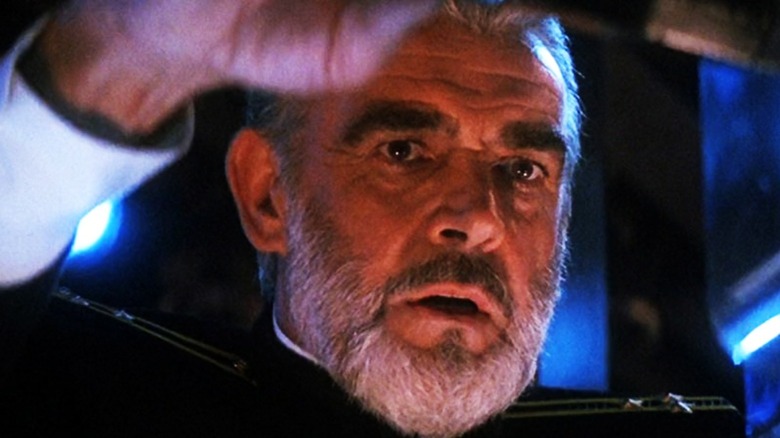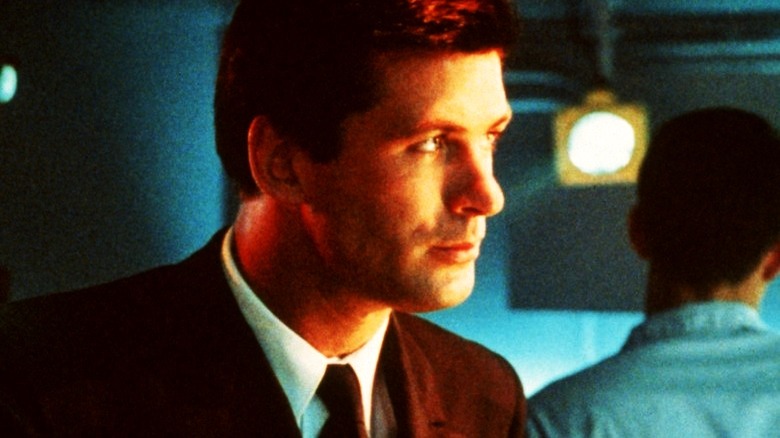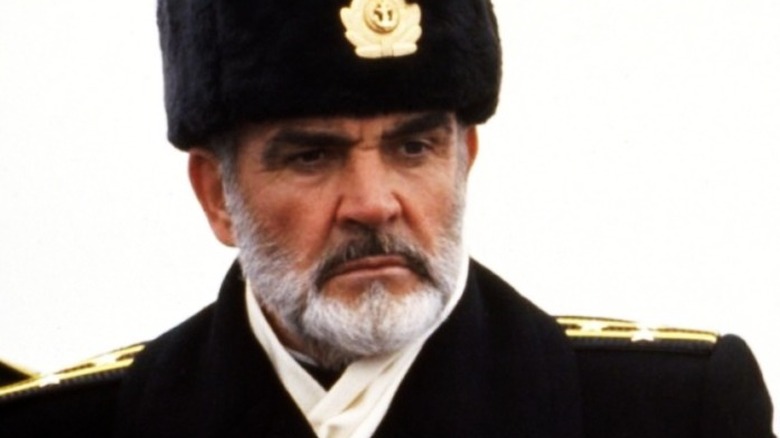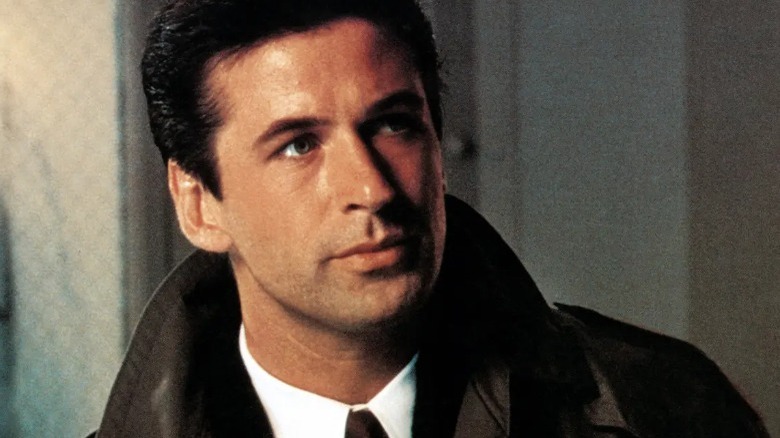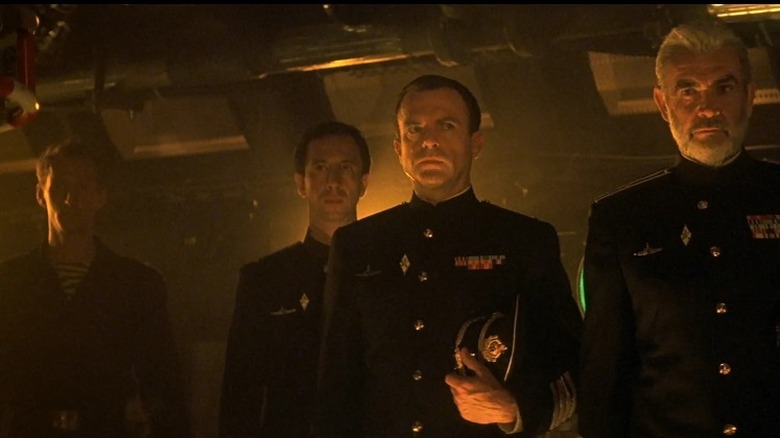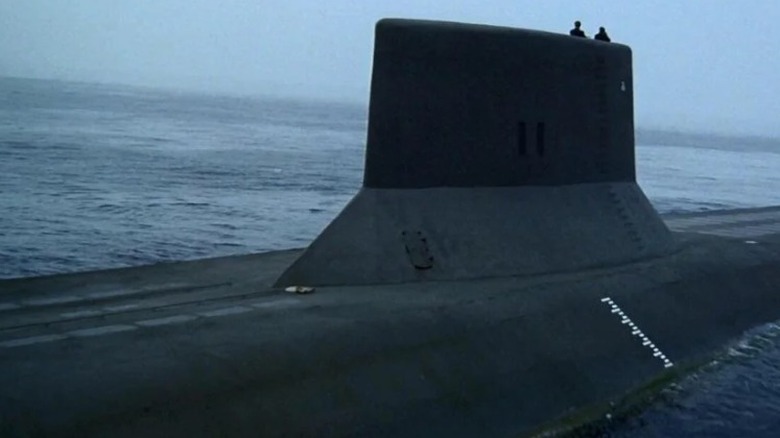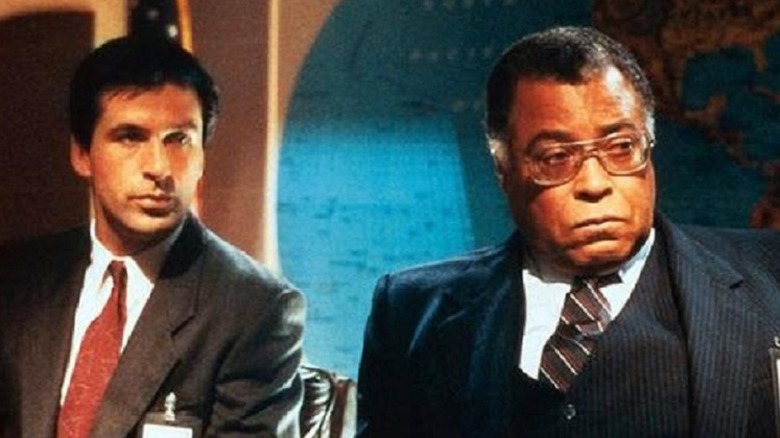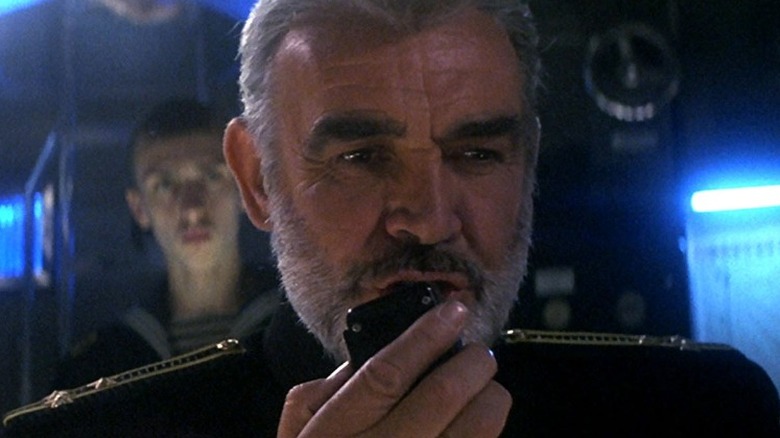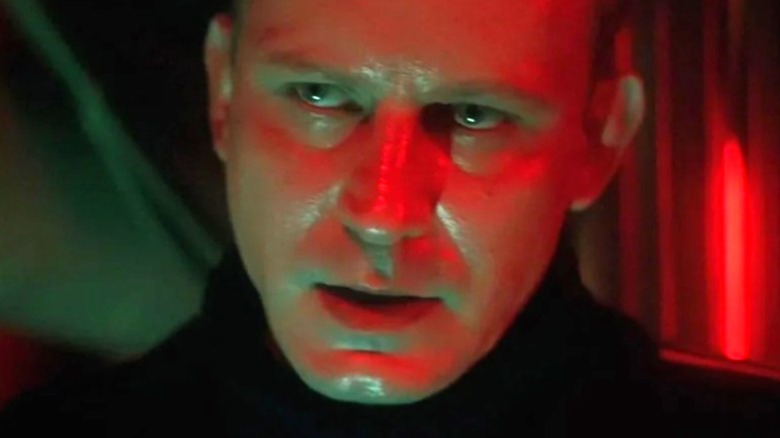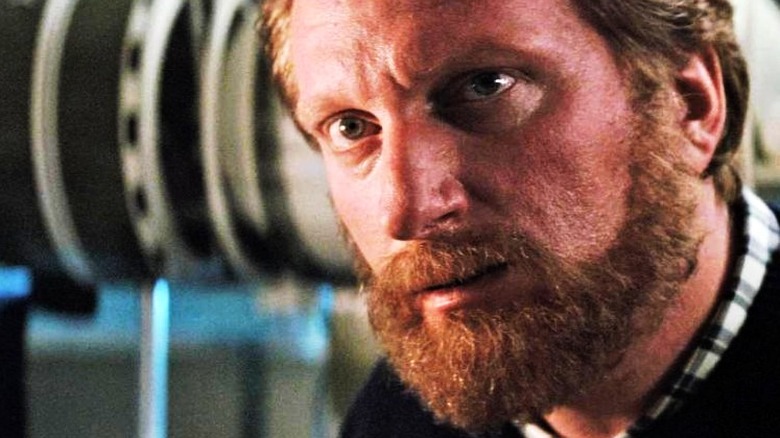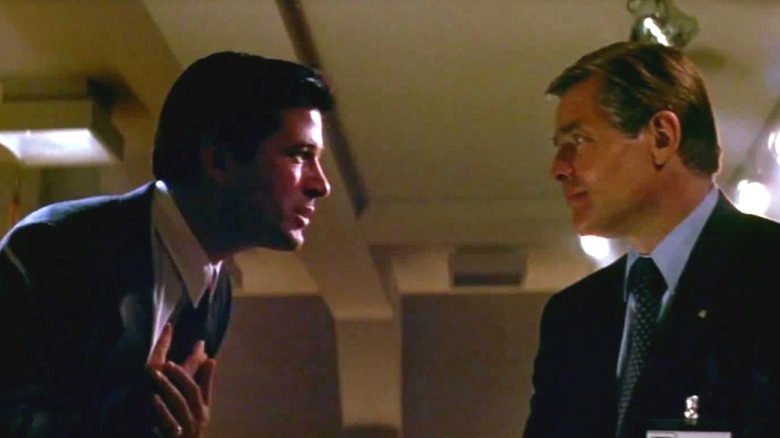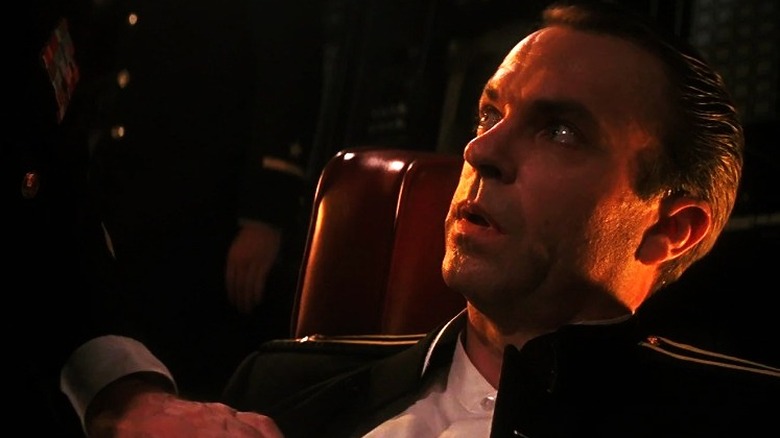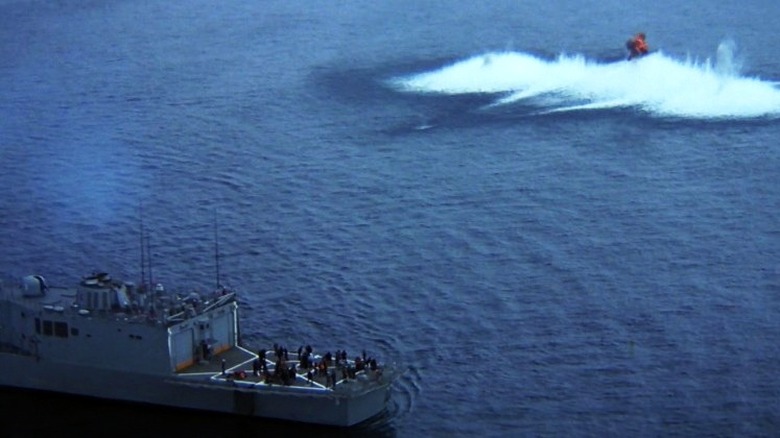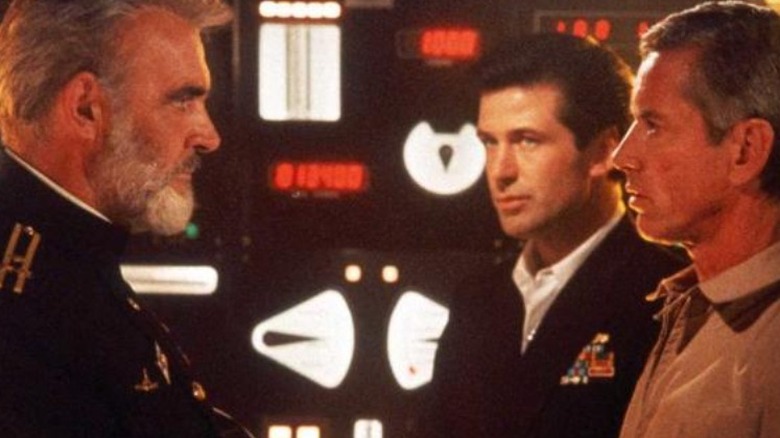The Big Differences Between The Hunt For Red October And The Book
Tom Clancy is one of the most well-known thriller writers in the world. Before he passed away in 2013, Clancy became famous for his military-inspired novels, most notably those that featured the fictional character Jack Ryan. He wrote 17 New York Times best-sellers over the course of his career, and more than 100 million copies of his books remain in circulation around the world. His name was also attached to a wide array of adaptations and products, ranging from blockbuster movies to video games.
Clancy's debut novel, and the first to feature Jack Ryan, was "The Hunt for Red October." The story of a submarine captain who defects from the Soviet Union to the United States, it was adapted into a 1990 film helmed by "Predator" and "Die Hard" director John McTiernan and starring Sean Connery and Alec Baldwin. But as you might expect from any film adaptation of a novel, there were many changes made to the source material. These are just the biggest differences between the book and movie versions of "The Hunt for Red October."
The entire timeline is condensed
It doesn't matter whether a film adaptation is good or bad, there's one common thing that almost all of them share: They all have to condense the story of the book they're adapting to fit the time constraints of a movie. While readers are perfectly happy to spend days pouring over a novel, the same can't be said of movie audiences. Even the longest films typically don't last more than three hours, and that means that it's usually impossible to include everything from a book.
"The Hunt for Red October" is no exception. One of the biggest differences between the movie and the book is just how spread out the action is. In the novel. Jack Ryan doesn't immediately figure out what Captain Ramius is attempting to do, and his discussions with his bosses take place over the course of several days rather than just a conversation or two. This makes everything feel a bit more rushed and frantic in the film, while the novel's characters seem more considered and take more time to make decisions.
Captain Ramius' motivation is very different
Although Jack Ryan is the main protagonist of "The Hunt for Red October," Captain Marko Ramius plays just as important a role. But the character isn't portrayed exactly the same way between the book and the film, and one place the two versions of the story differ is in Ramius' motivations for defecting from the Soviet Union in the first place.
When explaining his reasons for escaping from his motherland to Ryan in the closing scenes of the film, Ramius says, "Well, there are those who believe that we should attack the United States first. Settle everything in one moment. Red October was built for that purpose." Ramius is well aware that the Red October submarine poses a threat to the balance of power in the world and could lead to the destruction of the U.S., or an all-out war. He defects to avoid this possibility.
However, in the novel, his reasoning is more complex and nuanced. While it's true that he feels the Red October is a destabilizing weapon, he has also lost any confidence in the Soviet Union. There is a long list of causes, including the prosecution of his parents and the obstacles placed in his way during his career, but the main one is the death of his wife, which Ramius blames on the incompetence of the Soviet Union — specifically the drunk doctor who botched a medical operation, but wasn't punished due to his family's connections to the Soviet government.
There's no HMS Invincible
"The Hunt for Red October" movie essentially depicts a battle between the United States and the Soviet Union. The two sides of the Cold War conflict are each racing to get to the submarine first, and while they never come close enough to actually fight each other, the suspense and threat of escalation is always there.
That's not strictly the case in the book. As well as the U.S. and Soviet Union, Britain's Royal Navy also plays a role, particularly the task force that aids Jack Ryan. In fact, two important characters from the book include Vice-Admiral John White and Lieutenant Owen Williams, who are both serving on the HMS Invincible.
Ryan himself spends time on the Invincible, and the ship and its accompanying vessels play a big role in the story. Without the ship and the help of Owen Williams, who happens to speak Russian, Ryan might not have been able to board the Red October and make contact with Captain Ramius and the other officers on board.
The submarine crew is less loyal to Ramius
Another major difference between the novel and the film can be seen in the loyalty of Ramius' officers. In the movie, they are not obedient lap dogs who are prepared to do anything for their captain. While most of them are in on the plot — other than medical officer Dr. Petrov and political officer Ivan Putin — that doesn't mean they agree with everything Ramius does. In one scene, when Ramius reveals that he has killed Putin and warned the Soviet command about their plans, the crew express their shock and dismay over his decisions. Some openly criticize what he has done — even executive officer Vasily Borodin (Sam Neill) questions it.
Things are very different in the book version. Here, Ramius has handpicked his entire crew of officers, filling the positions with men loyal to him and his cause. Each of them is as dissatisfied with Soviet rule as their captain and have seen their careers stall, prompting them to want a new life in the West. The killing of Putin is seen as a necessary action, and he was disliked by all of the other officers, anyway. None of them question Ramius or undermine him in any way during the story.
The Soviet attacks on the Red October are different
After discovering what Ramius and his crew are trying to do, the Soviet Union naval commanders send a task group to try and track down the renegade submarine and stop it from being found by the Americans. They come closest to succeeding when a bomber attacks the Red October. This aircraft is an anti-submarine weapon known as the ASW Tupolev Tu-142 Bear — it drops ordinance that is designed to detonate underwater and damage the submarine.
In the novel, the attack on the Red October is far more sustained and deadly. Several ships and submarines get close to the Red October during their pursuit as the Soviets attempt to stop Ramius. One chapter from the book sees another Soviet submarine attempt to catch up to the Red October by running its engines above the maximum output. While this does help the sub make up some of the distance, it eventually leads to the engines overheating and going into meltdown — everyone onboard is killed during the disaster other than a single survivor. Nothing this substantial happens in the movie version of the story.
The caterpillar drive is vastly different
The Red October is an experimental submarine with a state-of-the-art stealth propulsion system — the caterpillar drive. This drive effectively stops the submarine from making the noise that a traditional engine would, allowing it to avoid sonar and other detection technology and remain hidden. That would allow the Red October (or similarly-outfitted submarines) to travel into enemy waters and launch an attack with almost no warning.
While the basic concept is the same in both the book and the film, the exact ways in which the two drives work differs. In the movie, the caterpillar drive is described as a magnetohydrodynamic drive that puts current through seawater, forcing the water to squirt out of a jet thanks to a powerful magnetic field. The caterpillar drive in the novel, on the other hand, works in a modified way. Rather than electromagnets, the power system is a tunnel drive that utilizes water jets and impellers. This allows the drive to build up pressure and expel water to generate thrust. Again, it is a way of moving the submarine without causing much mechanical noise, giving it an advantage over traditional drive systems.
Captain Ramius' true intentions are initially a mystery
One of the main plot points in the movie "The Hunt for Red October" is the question of whether Captain Ramius is genuinely a villain, or actually means to defect and hand over the Red October to the Americans. It takes Jack Ryan some time to figure out the sailor's true intentions, and viewers don't know exactly what will happen. Scenes showing what Ramius is actually planning on doing don't come until well into the film, when he reveals that he has sent a letter to Moscow containing details on his defection and his plan to give the revolutionary submarine to the Soviet Union's enemies.
The book is far more explicit about what Ramius is doing from the beginning — the very first chapter reveals the thoughts and feelings of the disaffected captain and gives some information about his personal life. This puts readers in a different position, as they know exactly what the officers of the Red October are trying to accomplish. The suspense comes instead from not knowing whether the United States forces will realize this in time, or whether the pursuing Soviet forces will catch and stop Ramius.
Tupolev is more dedicated to stopping Captain Ramius
Captain 2nd rank Viktor Tupolev (Stellan Skarsgård) is the commanding officer of the Alfa-class attack submarine Konovalov and a former student of Captain Ramius. He essentially acts as the main villain in the film and is charged with hunting down the missing submarine and stopping his ex-mentor. A cold-hearted and dedicated sailor, Tupolev fully intends to do his duty and prove that he is a better captain than Ramius. He's totally focused on destroying the Red October before it can be handed over to the United States, shows no remorse about having to kill Ramius, and is only stopped when his ego gets in the way of his tactical thinking, causing his submarine to be destroyed by his own torpedo strike.
Conversely, in the book, Tupolev is not as hell-bent on proving that he is the superior commander and shows some trepidation about having to fight Ramius directly. He does so because of his duty to his country, and it's never explicitly made clear whether he truly believes that Ramius is defecting or has gone rogue. In that respect, he may be acting to stop a potential war with the United States, given the Red October's potential to launch a nuclear attack.
Skip Tyler plays a less prominent role
Oliver Wendell Tyler (Jeffrey Jones), otherwise known as Skip, is a former United States Navy officer who was forced to retire from active service after losing one of his legs in an accident. Rather than leave the military altogether, he takes up a teaching position at the United States Naval Academy in Maryland, where he acts as an instructor to recruits hoping to become officers. He also serves as a consultant, providing his opinion and expertise when called upon.
In both the movie and the novel, Jack Ryan works with Skip to determine what makes the Red October special. The instructor is able to work out that it's housing a new drive system that would provide almost silent propulsion. This assessment proves essential in allowing Ryan to determine that Ramius intends to defect. However, Skip's role diverges at this point depending on whether you're reading the book or watching the movie. In the film, that's pretty much it for Skip. In the novel, though, he's a far more important character, coming up with a plan to help get the Americans in contact with the Red October and for Ryan to get on board. Later, Skip comes up with another plan to fool the Russians into thinking Ramius has been killed and the submarine sunk so the Navy can recover it safely.
There's no mole
Every film adaptation has to ignore parts of the book it's based on — there's simply too much material in most books. That generally means some minor storylines have to be dropped, certain characters changed or left out, and plot details significantly altered.
When it comes to "The Hunt for Red October," one of the storylines the movie ignores completely is that of a Soviet mole working in the United States to pass information along to the Russians. Peter Henderson is a KGB mole who infiltrated the U.S. government as an aide in the Senate. First introduced in "The Hunt for Red October," he plays a part in several additional Tom Clancy novels.
Henderson is ultimately discovered by the CIA and FBI and turns against his Soviet masters. Now working as a double agent, he is able to feed false information to the KGB and is ultimately allowed to go free because of the extensive knowledge he has of the Soviet Union and the role he plays in combating them.
Borodin is a far more sympathetic character
Captain 2nd Rank Vasily Borodin is the executive officer aboard the Red October and Ramius' second-in-command. He is intensely loyal to his captain and ensures the rest of the officers carry out their duties and stick to the plan. His character is significantly altered between the book and the film, though, and he might not be as likable among readers.
One of the most obvious differences is that Borodin is killed in the movie, whereas he ends up as one of the surviving officers in the novel. He's also a warmer and seemingly gentler person in the film, even waiting until the rest of the officers leave before questioning Ramius' decision to send a letter to Moscow detailing their defection. Hoping for a simple life in America, he details his desire to live in Montana and raise rabbits (which probably should have tipped us off that he wasn't going to make it).
Borodin is not as sympathetic in the book, which portrays him as more cold-hearted and dispassionate. In fact, one of the main problems he has with the Soviet Union is that a person he reported as being homosexual was not punished, prompting him to become disillusioned with his commanders. That part definitely didn't make it into the movie script.
The plan to fool the Soviets is different
Things work out rather fortuitously in the movie version of "The Hunt for Red October" when it comes to fooling the Soviet forces into thinking the submarine has been sunk rather than captured by the Americans. When the Red October is attacked by the Tupolev and the Konovalov, it's able to avoid destruction thanks to the help of the USS Dallas. The skirmish eventually ends in the Konovalov being destroyed, its explosion visible to the former crew of the Red October, who abandoned the submarine when Ramius faked a nuclear emergency onboard. The result is plenty of witnesses to say that the Red October was sunk, as the crew was unaware of the presence of the Konovalov.
In the novel, however, Jack Ryan and Skip Tyler come up with a different plan to deceive the Soviet forces. Ramius fakes the reactor emergency and prompts the evacuation of the crew, while he and his officers stay behind, suggesting that they will scuttle the Red October to prevent it falling into enemy hands. A decommissioned U.S. submarine is then blown up near the Red October, with some of the parts from the revolutionary submarine put in the wreckage to make it seem like the Soviet boat was sunk.
The Soviets ask the US for help destroying the Red October
As mentioned, part of the drama in "The Hunt for Red October" — at least in the early stages of the film — comes from not knowing whether Ramius is planning to defect or has simply gone rogue. This allows the Soviet Union to ask the United States to intervene in the crisis. At one point, the Soviet ambassador approaches the U.S. government to inform them that Ramius is actually planning to launch a nuclear attack on America. They directly ask for help from American military forces in tracking down and destroying the Red October.
On the other hand, the Soviet Union does its best to keep the Red October and Ramius' defection a secret from the United States for almost the entirety of the novel. Rather than ask for any assistance, they simply pretend that the Soviet forces are conducting an exercise and that nothing has gone wrong. This puts the opposing naval forces in a precarious position throughout the book, as the two sides cannot open fire on each other but come close to conflict several times.
